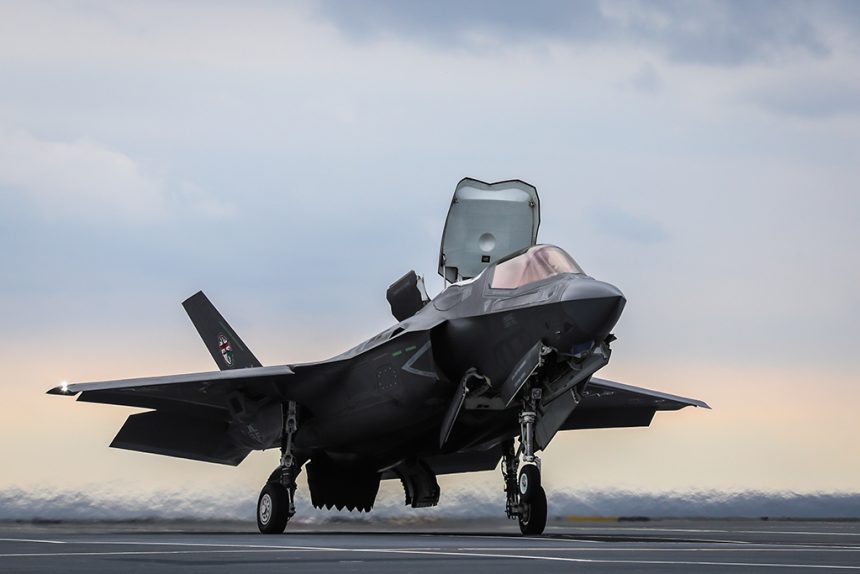The F-35 Patuxent River Integrated Test Force (ITF) achieved a new milestone performing a Shipborne Rolling Vertical Landing (SRVL) on aircraft carrier HMS Queen Elizabeth.
On Oct. 13, an F-35B STOVL (Short Take Off Vertical Landing) variant of the Joint Strike Fighter performed the first Shipborne Rolling Vertical Landing (SRVL) on the flight deck of HMS Queen Elizabeth, as part of the ongoing First of Class Flight Trials (Fixed Wing), or FOCFT (FW). BAE Systems test pilot Pete “wizzer” Wilson, achieved the F-35B’s first real SRVL touching down at about 40 knots and decelerating to a standstill in about 175 feet.
Britain’s newest aircraft carrier (able to accommodate up to 24 F-35Bs out of the planned 138 F-35 Lightning jets) and the F-35 Patuxent River Integrated Test Force (ITF) are conducting a variety of flight maneuvers and deck operations to develop the F-35B operating envelope for QEC carriers.

Among the most important parts of the trials are the rolling vertical landings: as the acronym suggests, STOVL aircraft use the vertical landing to return to the ship. Using this kind of procedure, the approaching aircraft slowly reaches a hovering position to the port side of the ship before moving sideways over the deck and descending slowly. This technique has pretty strict weight requirements because of the thrust required to keep the aircraft airborne the time needed to put the wheels down. The rolling technique is intended to allow pilots to recover to the ship with more stores: the combination of thrust from its rotating nozzle, lift-fan and lift generated by the wing as an effect of the (slow) forward movement of the aircraft can save up to 7000lbs greater all up weight (UAW). Without the SRVL technique, the F-35B would be forced to jettison some or all of its external store when returning to the ship.
According to some sources the Soviet Yak-38 “Forger” jets could perform rolling landings on carrier decks but required the use of a safety barrier net; however, it’s not clear whether actual tests were conducted at sea.
In order to prepare to the first SRVL pilots and engineers tested the new technique using BAE Systems’ F-35/QEC Integration Simulator—a full motion, dome simulator—based in Warton, England. Some 3,000 takeoffs and landings were important to discover “where the edges of the test envelope are,” said Royal Air Force Sq. Ldr. Andy Edgell, FOCFT (FW) lead test pilot at the Pax River ITF.
“SRVL tests are truly experimental,” Edgell said. “It involves landing a fast jet onto an aircraft carrier with forward relative speed but without the braking assistance typically provided by an arresting gear and hook. It’s going to be a really rewarding moment for British aviation to watch that procedure actually take place.”
Back in 2007, Qinetiq’s VAAC Harrier testbed was used by the Aircraft Test and Evaluation Centre using a “dummy deck” at Qinetiq’s Boscombe Down site in Wiltshire, to assess the possibility to perform SRVL approaches as a way to use thrust-vectoring to a slow speed while still gaining the benefit of wing-borne lift.
The UK is the only nation currently planning to use the SRVL technique. However, the US Marine Corps and the Italian Navy (which should operate the F-35B to replace the AV-8B+ Harrier II from Italy’s Cavour aircraft carrier in the future) might take advantage of the rolling landing in the future, leveraging the testing conducted by the F-35 ITF aboard HMS Queen Elizabeth.
Following the crash occurred on Sept. 28 and involving a U.S. Marine Corps F-35B, the U.S. Services and international partners temporarily suspended F-35 flight operations while conducting a fleet-wide inspection of a fuel tube within the engine on all F-35 aircraft. British F-35Bs involved in the flight trials from HMS Queen Elizabeth and Italian F-35 were not grounded though, as inspections did not find the faulty part.
Top image credit: Royal Navy / Crown Copyright









